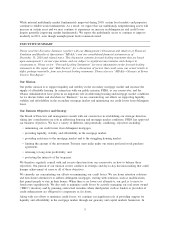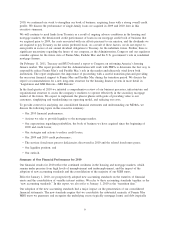Fannie Mae 2010 Annual Report Download - page 20
Download and view the complete annual report
Please find page 20 of the 2010 Fannie Mae annual report below. You can navigate through the pages in the report by either clicking on the pages listed below, or by using the keyword search tool below to find specific information within the annual report.-
 1
1 -
 2
2 -
 3
3 -
 4
4 -
 5
5 -
 6
6 -
 7
7 -
 8
8 -
 9
9 -
 10
10 -
 11
11 -
 12
12 -
 13
13 -
 14
14 -
 15
15 -
 16
16 -
 17
17 -
 18
18 -
 19
19 -
 20
20 -
 21
21 -
 22
22 -
 23
23 -
 24
24 -
 25
25 -
 26
26 -
 27
27 -
 28
28 -
 29
29 -
 30
30 -
 31
31 -
 32
32 -
 33
33 -
 34
34 -
 35
35 -
 36
36 -
 37
37 -
 38
38 -
 39
39 -
 40
40 -
 41
41 -
 42
42 -
 43
43 -
 44
44 -
 45
45 -
 46
46 -
 47
47 -
 48
48 -
 49
49 -
 50
50 -
 51
51 -
 52
52 -
 53
53 -
 54
54 -
 55
55 -
 56
56 -
 57
57 -
 58
58 -
 59
59 -
 60
60 -
 61
61 -
 62
62 -
 63
63 -
 64
64 -
 65
65 -
 66
66 -
 67
67 -
 68
68 -
 69
69 -
 70
70 -
 71
71 -
 72
72 -
 73
73 -
 74
74 -
 75
75 -
 76
76 -
 77
77 -
 78
78 -
 79
79 -
 80
80 -
 81
81 -
 82
82 -
 83
83 -
 84
84 -
 85
85 -
 86
86 -
 87
87 -
 88
88 -
 89
89 -
 90
90 -
 91
91 -
 92
92 -
 93
93 -
 94
94 -
 95
95 -
 96
96 -
 97
97 -
 98
98 -
 99
99 -
 100
100 -
 101
101 -
 102
102 -
 103
103 -
 104
104 -
 105
105 -
 106
106 -
 107
107 -
 108
108 -
 109
109 -
 110
110 -
 111
111 -
 112
112 -
 113
113 -
 114
114 -
 115
115 -
 116
116 -
 117
117 -
 118
118 -
 119
119 -
 120
120 -
 121
121 -
 122
122 -
 123
123 -
 124
124 -
 125
125 -
 126
126 -
 127
127 -
 128
128 -
 129
129 -
 130
130 -
 131
131 -
 132
132 -
 133
133 -
 134
134 -
 135
135 -
 136
136 -
 137
137 -
 138
138 -
 139
139 -
 140
140 -
 141
141 -
 142
142 -
 143
143 -
 144
144 -
 145
145 -
 146
146 -
 147
147 -
 148
148 -
 149
149 -
 150
150 -
 151
151 -
 152
152 -
 153
153 -
 154
154 -
 155
155 -
 156
156 -
 157
157 -
 158
158 -
 159
159 -
 160
160 -
 161
161 -
 162
162 -
 163
163 -
 164
164 -
 165
165 -
 166
166 -
 167
167 -
 168
168 -
 169
169 -
 170
170 -
 171
171 -
 172
172 -
 173
173 -
 174
174 -
 175
175 -
 176
176 -
 177
177 -
 178
178 -
 179
179 -
 180
180 -
 181
181 -
 182
182 -
 183
183 -
 184
184 -
 185
185 -
 186
186 -
 187
187 -
 188
188 -
 189
189 -
 190
190 -
 191
191 -
 192
192 -
 193
193 -
 194
194 -
 195
195 -
 196
196 -
 197
197 -
 198
198 -
 199
199 -
 200
200 -
 201
201 -
 202
202 -
 203
203 -
 204
204 -
 205
205 -
 206
206 -
 207
207 -
 208
208 -
 209
209 -
 210
210 -
 211
211 -
 212
212 -
 213
213 -
 214
214 -
 215
215 -
 216
216 -
 217
217 -
 218
218 -
 219
219 -
 220
220 -
 221
221 -
 222
222 -
 223
223 -
 224
224 -
 225
225 -
 226
226 -
 227
227 -
 228
228 -
 229
229 -
 230
230 -
 231
231 -
 232
232 -
 233
233 -
 234
234 -
 235
235 -
 236
236 -
 237
237 -
 238
238 -
 239
239 -
 240
240 -
 241
241 -
 242
242 -
 243
243 -
 244
244 -
 245
245 -
 246
246 -
 247
247 -
 248
248 -
 249
249 -
 250
250 -
 251
251 -
 252
252 -
 253
253 -
 254
254 -
 255
255 -
 256
256 -
 257
257 -
 258
258 -
 259
259 -
 260
260 -
 261
261 -
 262
262 -
 263
263 -
 264
264 -
 265
265 -
 266
266 -
 267
267 -
 268
268 -
 269
269 -
 270
270 -
 271
271 -
 272
272 -
 273
273 -
 274
274 -
 275
275 -
 276
276 -
 277
277 -
 278
278 -
 279
279 -
 280
280 -
 281
281 -
 282
282 -
 283
283 -
 284
284 -
 285
285 -
 286
286 -
 287
287 -
 288
288 -
 289
289 -
 290
290 -
 291
291 -
 292
292 -
 293
293 -
 294
294 -
 295
295 -
 296
296 -
 297
297 -
 298
298 -
 299
299 -
 300
300 -
 301
301 -
 302
302 -
 303
303 -
 304
304 -
 305
305 -
 306
306 -
 307
307 -
 308
308 -
 309
309 -
 310
310 -
 311
311 -
 312
312 -
 313
313 -
 314
314 -
 315
315 -
 316
316 -
 317
317 -
 318
318 -
 319
319 -
 320
320 -
 321
321 -
 322
322 -
 323
323 -
 324
324 -
 325
325 -
 326
326 -
 327
327 -
 328
328 -
 329
329 -
 330
330 -
 331
331 -
 332
332 -
 333
333 -
 334
334 -
 335
335 -
 336
336 -
 337
337 -
 338
338 -
 339
339 -
 340
340 -
 341
341 -
 342
342 -
 343
343 -
 344
344 -
 345
345 -
 346
346 -
 347
347 -
 348
348 -
 349
349 -
 350
350 -
 351
351 -
 352
352 -
 353
353 -
 354
354 -
 355
355 -
 356
356 -
 357
357 -
 358
358 -
 359
359 -
 360
360 -
 361
361 -
 362
362 -
 363
363 -
 364
364 -
 365
365 -
 366
366 -
 367
367 -
 368
368 -
 369
369 -
 370
370 -
 371
371 -
 372
372 -
 373
373 -
 374
374 -
 375
375 -
 376
376 -
 377
377 -
 378
378 -
 379
379 -
 380
380 -
 381
381 -
 382
382 -
 383
383 -
 384
384 -
 385
385 -
 386
386 -
 387
387 -
 388
388 -
 389
389 -
 390
390 -
 391
391 -
 392
392 -
 393
393 -
 394
394 -
 395
395 -
 396
396 -
 397
397 -
 398
398 -
 399
399 -
 400
400 -
 401
401 -
 402
402 -
 403
403
 |
 |

the future (for loans that eventually involve charge-offs or foreclosure), yet these fair value losses have already
reduced the mortgage loan balances reflected in our consolidated balance sheets and have effectively been
recognized in our consolidated statements of operations through our provision for guaranty losses. We consider
these fair value losses as an “effective reserve,” apart from our total loss reserves, to the extent that we expect
to realize them as credit losses in the future.
As a result of the substantial reserving for and realizing of our credit losses to date, we have drawn a
significant amount of funds from Treasury through December 31, 2010. As our draws from Treasury for credit
losses abate, we expect our draws instead to be driven increasingly by dividend payments to Treasury.
Our Strategies and Actions to Reduce Credit Losses on Loans in our Single-Family Guaranty Book of
Business
To reduce the credit losses we ultimately incur on our single-family guaranty book of business, we are
focusing our efforts on the following strategies:
• Reducing defaults to avoid losses that otherwise would occur;
• Efficiently managing timelines for home retention solutions, foreclosure alternatives, and foreclosures;
• Pursuing foreclosure alternatives to reduce the severity of the losses we incur;
• Managing our REO inventory to reduce costs and maximize sales proceeds; and
• Pursuing contractual remedies from lenders and providers of credit enhancement, including mortgage
insurers.
We refer to actions taken by our servicers with borrowers to resolve the problem of existing or potential
delinquent loan payments as “workouts,” which include our home retention solutions and foreclosure
alternatives discussed below. As “Table 4: Credit Statistics, Single-Family Guaranty Book of Business”
illustrates, our single-family serious delinquency rate decreased to 4.48% as of December 31, 2010 from
5.38% as of December 31, 2009. This decrease is primarily the result of workouts and foreclosed property
acquisitions completed during the year and reflects our work with servicers to reduce delays in determining
and executing the appropriate approach for a given loan. During 2010, we completed approximately 772,000
workouts and foreclosed property acquisitions. The decrease is also attributable to our acquisition of loans
with stronger credit profiles in 2010. Serious delinquency rates declined in 2010 and, as of September 30,
2010, we experienced the first year-over-year decline in our serious delinquency rate since 2007. This
year-over-year decline continued as of December 31, 2010. We expect serious delinquency rates will continue
to be affected in the future by home price changes, changes in other macroeconomic conditions, and the extent
to which borrowers with modified loans again become delinquent in their payments.
Reducing Defaults. We are working to reduce defaults through improved servicing, refinancing initiatives and
solutions that help borrowers retain their homes, such as modifications.
•Improved Servicing. Our mortgage servicers are the primary point of contact for borrowers and perform
a vital role in our efforts to reduce defaults and pursue foreclosure alternatives. We seek to improve the
servicing of our delinquent loans through a variety of means, including increasing our resources for
managing the oversight of servicers, increasing our communications with servicers, and holding servicers
accountable for following our requirements. We are also working with some of our servicers to test and
implement high-touch protocols for servicing our higher risk loans, including lowering the ratio of loans
per servicer employee, prescribing borrower outreach strategies to be used at earlier stages of delinquency,
and providing distressed borrowers a single point of contact to resolve issues.
•Refinancing Initiatives. Through our Refi Plus
TM
initiative, which provides expanded refinance
opportunities for eligible Fannie Mae borrowers, we acquired or guaranteed approximately 659,000 loans
in 2010 that helped borrowers obtain more affordable monthly payments now and in the future or a more
stable mortgage product (for example, by moving from an adjustable-rate mortgage to a fixed-rate
mortgage). These refinancing activities may help prevent future delinquencies and defaults. Loans
15
